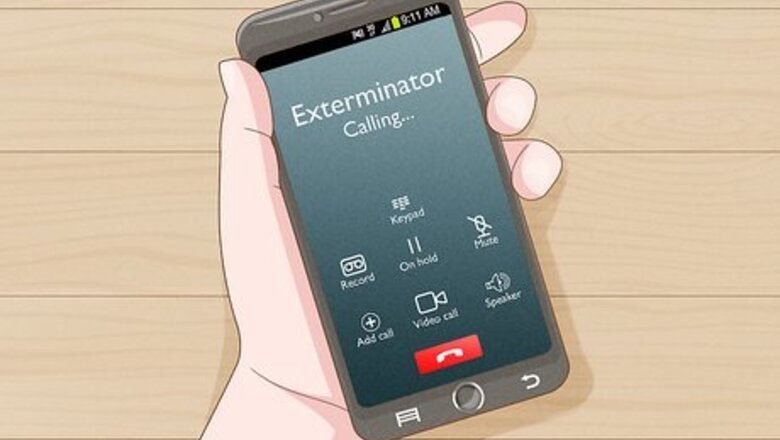
views
- Call an exterminator if you have any doubts about your ability to safely eliminate a wasp nest.
- Put on protective clothing, plan a route to leave the area quickly, and attack the nest at night or early in the morning.
- Use wasp spray (or soapy water) on open-cell nests, insecticide dust on concealed nests, and bagging-and-drowning with hanging nests.
Safety Measures
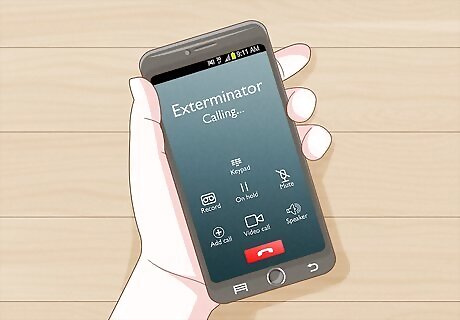
Call an exterminator if you have concerns (or are allergic). If you have any doubts whatsoever about your ability to safely destroy a wasp nest, make the smart choice and call in a professional. And always hire an exterminator if you are allergic to insect stings—the risks are simply too high. Strongly consider calling a pro if you have ground-nesting yellow jackets, which are hard to eliminate even with consumer-level insecticide dust products. If the wasp nest is in an awkward, high, or hard-to-reach location, such as inside a wall or attic or underneath a concrete slab, definitely get help from a professional. Even if you aren't allergic, approaching a wasp nest can be dangerous and, in rare instances, deadly if things go very wrong. It’s okay to play it safe and call an exterminator instead!
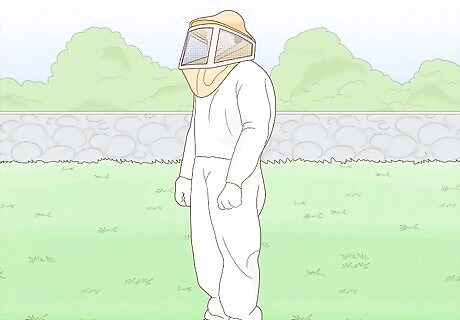
Cover your skin with protective clothing. It’s not a bad idea to wear a full beekeeper’s suit, but at very least be sure to wear protective clothing when you get rid of a wasp nest. Even if you're not allergic, a wasp sting can be painful! Wear long jeans, socks and boots, and a thick sweater or jacket. Tuck the bottom of your pants into your socks. Cover your head with a thick hood, cinched up tight, or a knit cap. Wrap a scarf around the lower half of your face and wear protective glasses or ski goggles. If you are using a pesticide spray, wear old clothes that you can wash or discard immediately afterwards. If you do get stung while getting rid of the nest, treat the sting by washing the area and applying ice. Get immediate medical help if you’re having trouble breathing or show other signs of a severe allergic reaction.
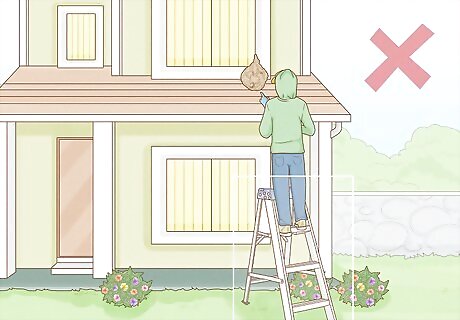
Stay off ladders to reach elevated wasp nests. If the wasp nest is well out of reach, such as under the eave of a two-story house or on a high tree branch, do not use a ladder to attempt to reach it. Maybe it’s okay to use a small stepladder that you can easily hop down from, but that’s as high as you should get off of the ground. If you are standing on a ladder and a swarm of wasps flies at you when you disturb the nest, you are very likely to fall and injure yourself. In this situation it is best to call a professional exterminator. You should only attempt to get rid of a wasp nest by yourself when it is within easy reach.
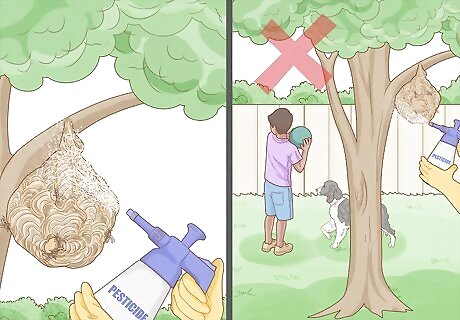
Keep children and pets away, especially when using pesticide. If you decide to use a pesticide spray or powder to kill off the wasps, it's important to section off the area and make sure no one—especially small children or pets—comes near it, at least for 24 hours. The pesticides used in wasp killing spray are extremely strong and poisonous. Pick up and dispose of any dead wasps that you find on the ground near the nest. Otherwise, your pet or local wildlife might ingest the dead wasps and potentially poison themselves.
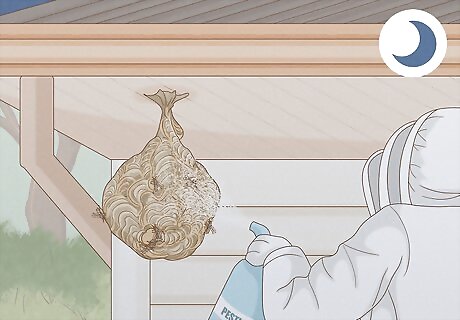
Destroy wasp nests at night or very early in the morning. If you are planning to get rid of a wasp nest yourself, do it when the wasps are least active—well after sunset. Between then and the following sunrise, their reaction time is slower, and they are less aggressive. For illumination, use a red or amber colored light—such as by covering your flashlight with red cellophane. Wasps cannot see this red color.
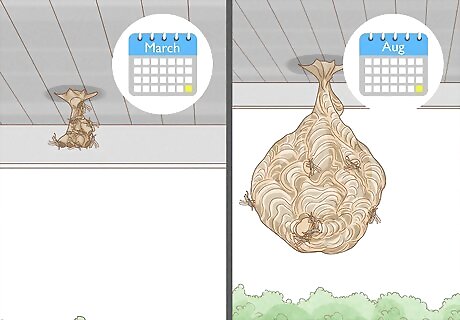
Target wasp nests earlier in the year whenever possible. The best time to kill a wasp nest is early spring, when the queen (just out of hibernation) builds up the nest with the help of the smaller first brood of workers. If you wait until late summer, the nest will be much bigger with larger broods of wasps that are in “protection mode” for next year’s queens. If you manage to kill the queen, which is easier to accomplish early in the year, the entire nest will disperse and/or die off. If you do not find the wasp nest until fall, destroying it may not be necessary since freezing nighttime temperatures will kill the colony off naturally.
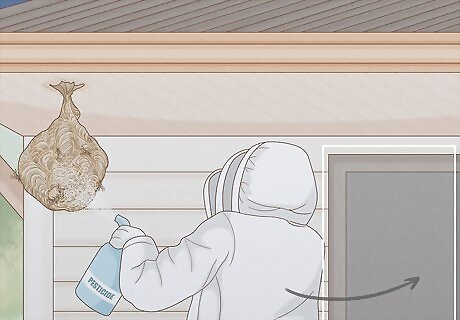
Plan an escape route so you can leave the area quickly. Before you set your plan of attack in motion, figure out how you’re going to get the heck out of there fast. After you spray the nest, the wasps will quickly start to stream out and may swarm at you—this is why it’s so important to plan a fast escape and to wear protective clothing. The safest place to go is back inside your home. Resist the urge to hang around and watch what happens to the nest! Make sure that there are no obstacles such as children's toys or gardening equipment in your path which you could potentially trip over.
Nest Elimination Options
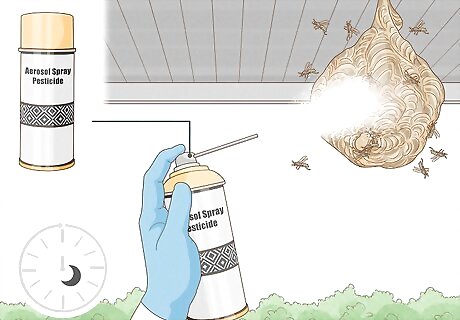
Saturate the nest with a wasp-killing pesticide spray. Wearing the proper protective clothing and following the safety measures outlined in this article, target the nest with a stream of pesticide. Do this for 10 to 15 seconds (or according to the instructions on the can), then quickly vacate the area. Return at least 24 hours later, during the daytime, to confirm that there is no longer any wasp activity. Wasp spray works best on open nests with exposed hexagonal cells (like paper wasp nests), since you can easily saturate all the cells and wasps. If it’s a closed nest (like with hornets), focus the stream on the main opening. Liquid pesticides are less effective on nests in the ground or in structures (like yellow jacket nests). Buy an aerosol pesticide designed especially for killing wasps. If you still see activity around the nest 24+ hours later, repeat the process a second time. Once wasp activity has ceased, knock down the nest, break it apart, saturate it with pesticide, and dispose of it.
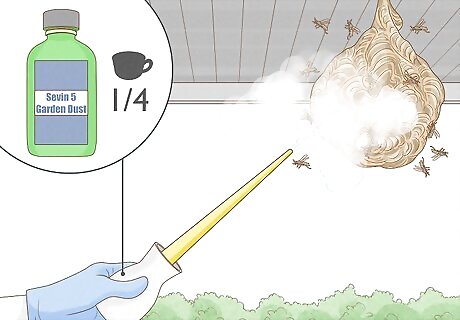
Use insecticidal dust on hidden nests (like ground nests). Insecticidal dust is much more effective than aerosol spray at penetrating the heart of nests built into a tree trunk, a shed wall, or the ground (like yellow jacket nests). While following all safety precautions, do the following: Buy an insecticidal dust, such as Sevin 5 Garden Dust, and measure out about 1/4 c (30 g) into a bulb duster (or disposable plastic cup). Apply the dust liberally onto/into the nest opening. Immediately vacate the area. Don't block or cover the opening. As wasps pass through the opening, their legs and wings will become coated with the insecticidal dust, which they will then carry with them into the center of the nest, contaminating the other wasps. Following the application of insecticidal dust, the wasps should die off within a day or two. If not, repeat the process.
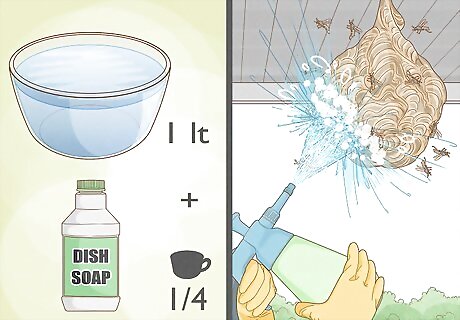
Use dish soap as a safer, fairly effective wasp killer. If you're not a fan of using pesticide, a simple solution of dish soap and water is surprisingly good at killing off wasps, as it coats their wings to prevent them from flying and eventually drowns them. Here’s how to use it: Prepare a soap solution by mixing about 2 fl oz (59 ml) of liquid dish soap with roughly 32 fl oz (0.95 L) of water. If you're targeting an aerial nest, pour the soap solution into a hose-end spray bottle, then aim a powerful stream of water directly at the entrance of the nest for at least 10 to 15 seconds. If you're targeting a ground nest, simply pour the solution directly into the entrance, then quickly vacate the area. Although the soap and water solution works, you may need to repeat the process several times, as the soapy water needs to come in direct contact with each wasp.
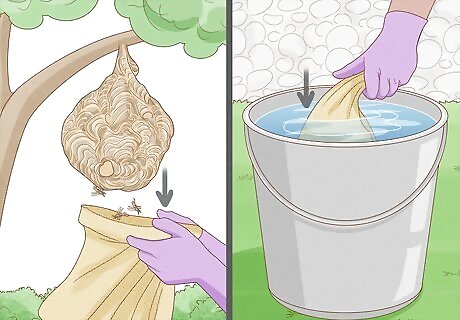
Bag and destroy a hanging nest. This method, which is only for enclosed, hanging nests (like hornet nests), involves coming in very close contact with the nest—so it is not for the faint-hearted! Here’s what to do: Quickly and carefully place a sturdy, hole-free cloth bag over the nest and tightly secure the top with string or duct tape. As you do so, pull the nest from the tree branch. Dump the bag containing the wasp nest into a bucket of water and place a heavy stone on top to hold the bag underwater. Leave the bag in the water for at least 8 hours to drown all the wasps. Alternatively, use a thick plastic trash bag and put it in the freezer for at least 2 days, or seal it in a 5 US gal (19 L) bucket with a tight-fitting lid for at least a week.
What kind of wasp (and nest) is it?
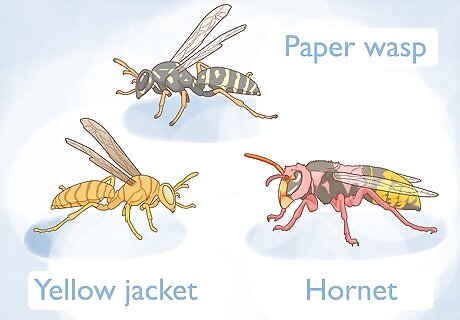
Paper Wasp Paper wasps have long bodies, long legs, and very skinny “waists,” compared to other wasps. They build large, exposed nests with clearly visible combs (hexagonal cells or chambers). Their nests are usually built in sheltered areas like the eaves of a house or the end of an open pipe. They only attack if they feel threatened, but their sting can be quite painful. It's good to know what species of wasp you're dealing with—this will impact the best way to get rid of it!
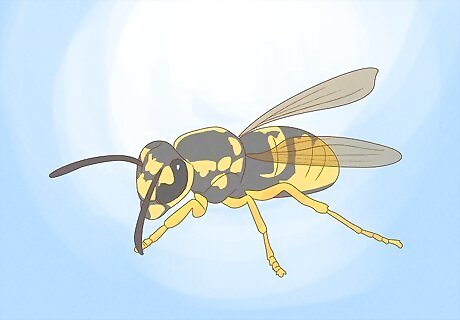
Yellow Jacket Yellow jackets have thick black antennae, fairly compact bodies, and shorter legs (compared to paper wasps). They build papery-looking, covered-in nests and prefer enclosed spaces like wall voids or cavities in the ground. They can be very aggressive, stinging multiple times and attacking in swarms. A single yellow jacket nest can contain thousands of wasps. Yellow jackets are sensitive to vibrations and may attack in large numbers if you, for instance, run a lawnmower over the opening to an underground nest.
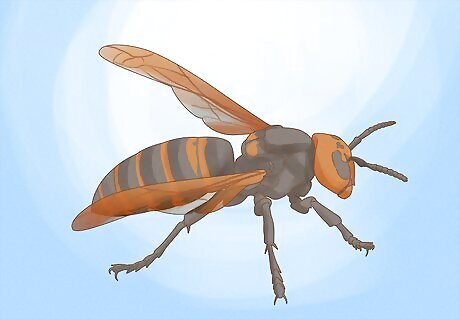
Hornet Hornets are the largest type of social wasp, compared to yellow jackets and paper wasps. They build large, enclosed paper nests with one or two openings. Nests containing up to 500 hornets may be built in tree trunks or wall cavities, but they’re often found hanging from tree branches. Hornets are generally less aggressive than yellow jackets, but will defend their nest ferociously if you get too close to it. In North America, the bald faced hornet is the most common—look for the white markings on its head and thorax. The European hornet, also found in North America, is brown with orange markings.
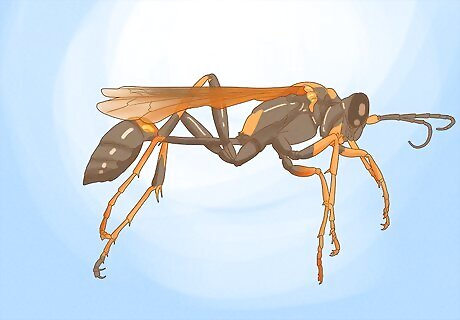
Mud Dauber Mud Daubers are solitary wasps that build small nests that look like splotches of mud against sheltered areas on tree trunks or houses. They have very thin “waists” like paper wasps, but this thin section connecting the thorax and abdomen is even more elongated. While mud daubers can cause a painful sting, they are rarely aggressive and can often just be left alone. Mud daubers can actually be very helpful to have around, since they kill pests like spiders in large numbers to feed to their young.
Prevention
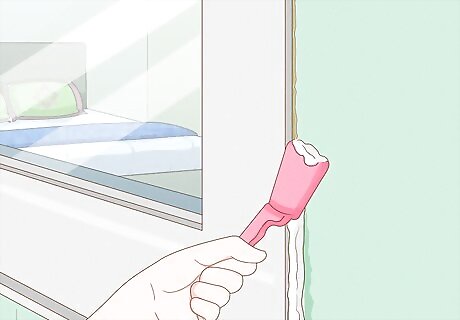
Seal off potential nesting sites on your home. Over the winter, do a thorough inspection of the outside of your house to look for potential wasp entry points, such as loose siding, unsealed vents, and cracks around windows and door frames. These are all ideal locations for a wasp nest, so seal them off now to prevent a potential infestation come spring. What’s worse than a wasp nest on your home? A nest that provides wasps with access into your home! Preventing wasps from nesting is always easier (and safer) than dealing with wasps once they’ve nested.
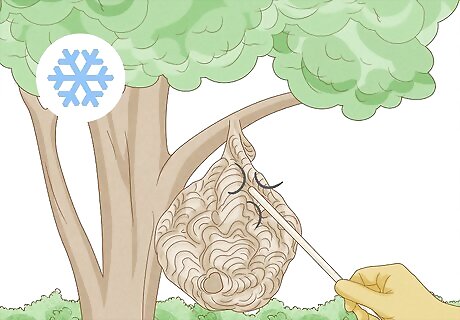
Knock down vacant nests in winter or early spring. Although wasps won’t return to their used nest, other wasps may incorporate the remnants of an old nest into their new one. Therefore it is a good idea to knock down any empty, abandoned nests and thoroughly clean the area before a queen wasp claims it by mid-spring.
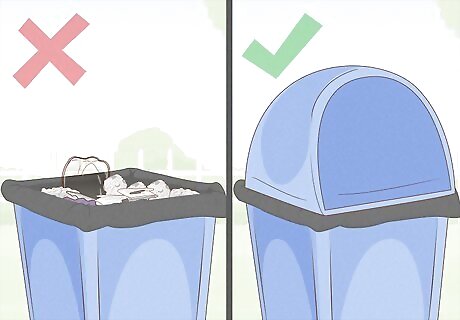
Seal your garbage cans to avoid attracting wasps. The scent of rotting food attracts wasps, and they may end up nesting in the area. In addition to keeping your trash cans well-sealed, give them a good cleaning on a semi-regular basis to remove any food residue.
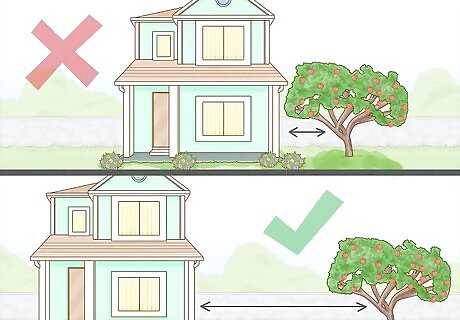
Keep fruit trees a safe distance from your home. Fruit trees—and particularly their rotting, fallen fruit—are a magnet for wasps, so think twice before planting one close to your home. If you already have fruit trees, regularly harvest ripe fruit and dispose of any fallen fruit before the wasps can get to it.
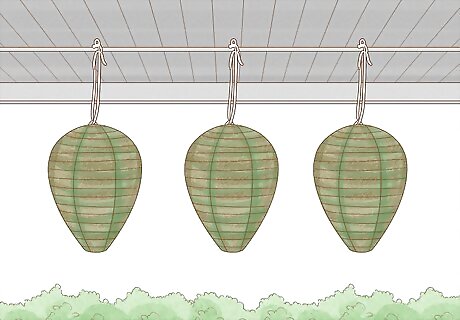
Hang fake nests to deter (real) nest-building. Wasps are extremely territorial and will not build their nest close to another one. Therefore, hanging a fake wasp nest or two is a great way to deter them. You can purchase fake nests (many of which are beautifully designed) at gardening centers and hardware stores , but you can have just as much success by hanging a brown paper bag!
















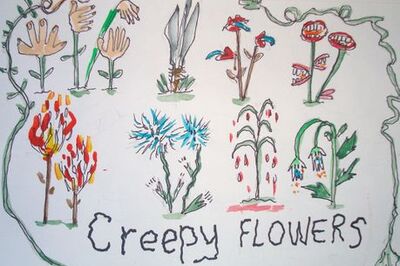
Comments
0 comment